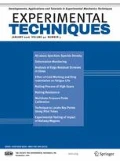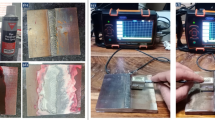Abstract
Due to its superior strength at high temperatures P/T91 steel is often applied in the chemical, petrochemical and fossil-fired power generation industries. The high strength is achieved by a suitable martensitic microstructure after appropriate heat treatment procedure. Welding is the most important process of joining the components in such plants, and the heat-affected zone is often the weakest part of these structures. Having in mind that the welded joint is the weakest area, it is necessary to know its properties and assess the level of its degradation. It was found that the life-limiting factor in case of P/T91 steel welded structures are the cracks located in the heat affected zones, more precisely in its intercritical region. In present paper the results of the fracture toughness measurement carried out on simulated P91 steel ICHAZ specimens produced using a weld simulator has been presented. The tests were done on two types of simulated specimens, those subjected to the subsequent PWHT and with those left untreated (without PWHT), at room temperature and 600 °C. For the J-integral estimation pin-loaded SEN(T) specimens were tested in plane stress conditions using the unloading compliance method of deriving a single specimen resistance curve and the η-method.








Similar content being viewed by others
References
Pandey C, Mahapatra MM, Kumar P, Saini N (2018) Some studies on P91 steel and their weldments. J Alloy Compd 743:332–364
Shibli A (2005) Material properties and heat treatment, training course P/T91 fabrication, welding, heat treatment, oxidation. Damage Mechanisms & Integrity/Life Assessment, London
Mannan SL, Laha K (1996) Trans Ind Inst Met 49(4):303–320
Milović L (2008) Significance of cracks in the heat-affected-zone of steels for elevated temperature application. Structural Integrity Life 8(1):55–64
Pandey C, Mahapatra MM, Kumar P, Saini N (2018) Homogenization of P91 weldments using varying normalizing and tempering tretment. Mat Sci Eng A-struct 710:86–101
Sawada K, Bauer M, Kauffmann F, Mayr P, Klenk A (2010) Microstructural change of 9 % Cr-welded joints after long-term creep. Mat Sci Eng A-struct 527:1417–1426
Hongo H, Tabuchi M, Watanabe T (2012) Type IV creep damage behaviour in Gr.91 steel welded joints. Metall Mater Trans A 43A:1163–1173
Albert SK, Matsui M, Watanabe T, Hongo H, Kubo K, Tabuchi M (2003) Variation in the Type IV cracking behaviour of a high Cr steel weld with post weld heat treatment. Int J Pres Ves Pip 80:405–413
Albert SK, Matsui M, Hongo H, Watanabe T, Kubo K, Tabuchi M (2004) Creep rupture properties of HAZs of a high Cr ferritic steel simulated by a weld simulator. Int J Pres Ves Pip 81:221–234
Milović L (2009) Steels for elevated temperature application: Heat-affected-zone specifics. In: Fundamentals of Fracture Mechanics and Structural Integrity Assessment Methods, monograph, ed. Sedmak S., MF, TMF, DIVK and IMS, pp 297–308
Lojen G, Vuherer T (2020) Optimization of PWHT of simulated HAZ subzones in P91 steel with respect to hardness and impact toughness. Metals 10(9):1215. https://doi.org/10.3390/met10091215
Cravero S, Ruggieri C (2007) Estimation procedure of J-resistance curves for SE(T) fracture specimens using unloading compliance. Eng Fract Mech 74:2735–2757
Kim Y-J, Budden PJ (2001) Plastic η factor solutions of homogeneous and bi-material SE(T) specimens for toughness and creep crack growth testing. Fatigue Fract Eng Mater Struct 24(11):751–760
Milović L (2010) Microstructural investigations of the simulated heat affected zone of the creep resistant steel P91. Mater High Temp 27(3):233–242
Milović L, Vuherer T, Blacic I, Vrhovac M, Stankovic M (2013) Microstructures and mechanical properties of creep resistant steel for application at elevated temperatures. Mater Design 46:660–667
Milović L, Vuherer T, Zrilic M, Sedmak A, Putic S (2008) Study of the simulated heat affected zone of creep resistant 9–12 % advanced chromium steel. Mater Manuf Process 23(6):597–602
Vuherer T, Dunđer M, Milović L, Zrilić M, Samardžić I (2013) Microstructural investigation of the heat-affected zone of simulated welded joint of P91 steel. Metalurgija 52(3):317–320. https://pubweb.carnet.hr/metalurg/arhiva/category/casopis-metalurgija/arhiva/2013
Oliveira GP, Donato GHB. Estimation procedures for J and CTOD fracture parameters experimental evaluation using homogeneous and mismatched pin-loaded SE(T) specimens. Proceedings of the ASME 2010 Pressure Vessels&Piping Division PVP2010-25796
Gubeljak N, Predan J, Kozak D (2012) Leak-before-break analysis of a pressurizer - estimation of the elastic-plastic semi-elliptical through-wall crack opening displacement. Integritet i vek konstrukcija 12(1):31–34
ASTM E1457-19E1: Standard Test Method for Measurement of Creep Crack Growth Times in Metals. STANDARD by ASTM International, 11/15/2019
Anderson TL (2005) Fracture mechanics, 3rd edn. CRC Press, Boca Raton
Acknowledgements
This work was supported by the Ministry of Education, Science and Technological Development of the Republic of Serbia (Contract No. 451-03-9/2021-14/200135).
Author information
Authors and Affiliations
Corresponding author
Ethics declarations
Conflict of Interest
The authors of the paper entitled “J-integral analysis of the simulated heat-affected zone of the elevated-temperature martensitic steel” have no financial or proprietary interests in any material discussed in this article.
Additional information
Publisher’s Note
Springer Nature remains neutral with regard to jurisdictional claims in published maps and institutional affiliations.
Rights and permissions
About this article
Cite this article
Zečević, B., Milović, L., Burzić, Z. et al. J-integral Analysis of the Simulated Heat-affected Zone of the Elevated-temperature Martensitic Steel. Exp Tech 46, 385–393 (2022). https://doi.org/10.1007/s40799-021-00487-9
Received:
Accepted:
Published:
Issue Date:
DOI: https://doi.org/10.1007/s40799-021-00487-9




